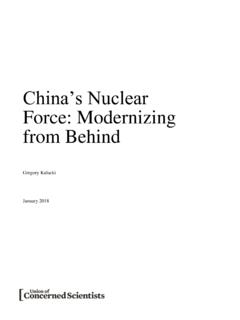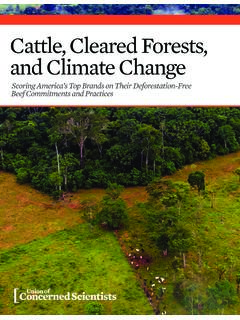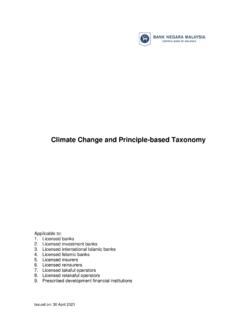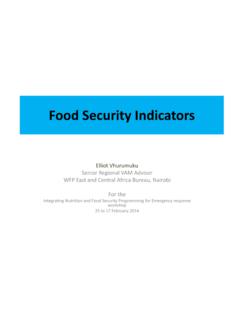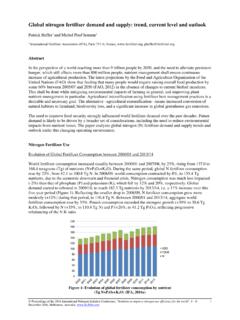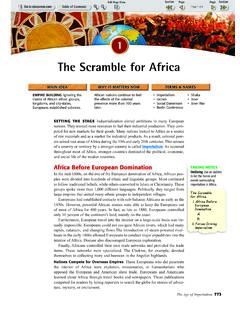Transcription of Palm Oil and Global Warming - Union of Concerned Scientists
1 FACT SHEETFORESTS AND PEATLANDS AT RISKC urrent methods of palm oil production often cause the destruction of carbon-rich forests and peatlands. When deforestation and peatland drainage occur to make way for oil palm plantations, the sequestered carbon is released into the atmosphere as carbon dioxide, contributing to Global Warming . As demand for palm oil increases, tropical forests and peatlands and the people and species that rely on them are put at risk. For all these reasons, it is important to transform the industry by making smart decisions about where and how palm oil is oil is ubiquitous in the Global marketplace. It is an ingredient in thousands of everyday products, from baked goods to shampoo. And it is used to fry fast food and to fuel cars and trucks in many places around the world. Unfortunately, because current palm oil production methods often cause the destruction of carbon-rich tropical forests and peatlands, it is a major contributor to Global Warming .
2 In order to conserve our natural resources, protect biodiversity, and reduce our risk of climate change, we must transform the palm oil Is Palm Oil?Palm oil is pressed from the fleshy fruit of the oil palm tree, Elaeis guineensis, a species native to Africa that also thrives elsewhere in the humid tropics. The utilization of palm oil has risen dramatically in recent years, reflecting an increased demand for vegetable oil; today about a third of all vegetable oil used worldwide is palm oil (Singh et al. 2013). As Figure 1 (p. 2) shows, Global production of palm oil was some 50 million metric tons per year in 2012, having more than doubled since 2000 (FAO 2013).This growth in palm oil production is likely to continue for the foreseeable future. Because of its high yield (about five to eight times more volume per hectare than the yields of its closest oil-crop competitors) (FAO 2013) and relatively low labor costs (sometimes due to forced or child labor), palm oil is the most inexpensive vegetable oil on the market today.
3 New research showing a link between the trans fats in partially hydrogenated oils and health risks such as heart disease has also led to an increase in the use of palm oil, which is low in trans fats, as a replacement oil in many processed foods. In addition, biodiesel fuel made from vegetable oil is currently a large market for palm oil and has the potential to expand Oil and Global WarmingWith peat smoldering in the background, a worker carries an oil palm sapling onto fire-cleared land planted in 2012 in Sumatra, Indonesia. Planting oil palm on peat swamp forests is particularly harmful to the climate, as it releases the carbon stored both in the rich peat soils and forest vegetation. Paul Hilton Photography2findi dt hdiheuiel yhneirnyryEmissions due just to oil palm cultivation in Indonesia accounted for an estimated 2 to 9 percent of all tropical land use emissions from 2000 to 2010 (Carlson and Curran 2013).
4 Indonesia was the world s seventh-largest emitter of Global Warming pollution in 2009, and deforestation accounted for about 30 percent of these emissions (WRI 2013). Indeed, for that same year Indonesia ranked second (behind Brazil) in the amount of Global Warming pollution it produced because of deforestation (WRI 2013). Because Global demand for palm oil is projected to continue rising, Southeast Asian, African, and Latin American forests as well as other tropical ecosystems that store large amounts of carbon are all at risk for development. Indonesia has already announced plans to double its palm oil production by 2020. And both Indonesia and Malaysia aim to dedicate millions of metric tons of palm oil to producing biofuels (Carter et al. 2007). While the use of fuels made from vegetable oils is growing rapidly as an alternative to fossil fuels, some countries, including the United States, have restricted or excluded palm oil-based biofuels because of concerns about environmental impact.
5 PEATLANDS AND FIREW hile forests are huge storehouses for carbon, the peat soils on which some of them grow can contain even more carbon as much as 18 to 28 times that of the forests themselves (Page, Rieley, and Banks 2011). Because peat soils are found in swampy areas with a high water table, the leaves and woody Carbon-Rich Ecosystems at RiskFORESTS AND BIODIVERSITYAs Figure 2 (p. 3) shows, oil palm plantations worldwide take up million acres ( million hectares) a total area greater than the state of Georgia (FAO 2013). Approximately 85 percent of palm oil is grown in Indonesia and Malaysia, much of it at the expense of forests. This destruction is devastating for local animals and plants, as well as local peoples who rely on these ecosystems for food and their livelihoods. Areas in Southeast Asia at risk of deforestation serve as a habitat for the Sumatran orangutan, elephant, and tiger, all of which are critically endangered, as well as for the endangered Bornean orangutan and pygmy elephant, among numerous other species.
6 Many of these forest species are found nowhere else on Earth, and only about 15 percent of them can also survive in oil palm plantations (Fitzherbert et al. 2008).When tropical forests are cleared to make way for oil palm plantations, carbon is released into the atmosphere as carbon dioxide (CO2), the gas that is the leading cause of Global Warming ; tropical deforestation accounts for about 10 percent of total Global Warming emissions (UCS 2013). But precisely because tropical forests store large amounts of carbon both in primary (old-growth) forests and secondary (disturbed and regenerating) forests it is important to protect these lands from oil palm development. Palm oil is an ingredient in thousands of products on the market today, from instant noodles to cookies to soaps. While Indonesia and Malaysia lead the world in palm oil production, other countries hope to increase their market share.
7 Thus forests and other tropical ecosystems elsewhere in Asia, as well as in Africa and Latin America, are at risk for SOURCE: FAO 2013 Indonesia26,094 All Other Palm Oil-ProducingCountries: 2,118 Malaysia20,707 Thailand1,764 Colombia1,066 Nigeria1,036 Papua New Guinea584C te d Ivoire461 Cameroon355 Brazil342 (tie)Honduras435 Guatemala342 (tie)3421786510109 FIGURE 1. Top 10 Palm Oil-Producing Countries, 2012 (Thousands of Tons of Oil Produced)3 Palm Oil and Global Warmingthe soil, an expensive process that needs to be continually repeated during the crop cycle. This drainage makes the peat decompose (causing heat-trapping emissions that often continue for decades) and then compact, thereby lowering the level of the land and making it even with the water table again, which prompts another drainage cycle. Further, peat soil is often too acidic to grow oil palm without additional chemical inputs, and oil palm trees planted on peat have a high rate of disease.
8 Finally, drainage drastically increases the peat s susceptibility to is often intentional it is an easy way for many companies and local residents to clear land for agriculture. But the process is extremely destructive. Some of the world s largest fires have occurred on drained peatlands, releasing hundreds of years worth of sequestered carbon, sending pollutants into the atmosphere, and burning for weeks or even months. During June 2013, such fires in Indonesia became an international health concern. They caused smog, haze, and respiratory problems as far away as Malaysia and Singapore. And in very dry years, emissions can be extraordinarily high. In 1997, for example, fires burning peat and vegetation in Indonesia released as much CO2 into the atmosphere as the United States released that whole year (EPA 2013; Page et al. 2002).Better Protection Is NeededGiven the dual threat of depleted natural resources and increased Global Warming emissions, oil palm plantations should not be allowed to encroach on the remaining tropical forests and peatlands.
9 This is not a new challenge, but efforts so far have been Roundtable on Sustainable Palm Oil (RSPO) a worldwide body made up of oil palm plantation owners, palm oil traders, companies that use palm oil in their products, materials that fall from the trees to the forest floor do not fully decompose; they accumulate, storing carbon as a result. Over time, these soils build to a depth ranging from 1 foot ( meter) to around 65 feet (20 meters) (Anderson 1983) about the height of a six-story building! As natural carbon sinks that keep CO2 out of the atmosphere, intact peatlands are vital to the reduction of Global Warming . Southeast Asia, and especially Indonesia, is rich in tropical peat soils; these soils contain some three-quarters of the world s tropical peat-soil carbon (Page, Rieley, and Banks 2011) an amount comparable to the carbon stored in the aboveground vegetation of the Amazon forest (van der Werf et al.)
10 2008). If all of this peat-stored carbon were released into the atmosphere, it would be equivalent to the carbon emissions from about nine years of Global fossil fuel use (van der Werf et al. 2008). Unfortunately, palm oil companies are increasingly destroying the swamps in order to make way for plantations even though the growing conditions on peat are far from ideal. To plant oil palm trees it is first necessary to drain water from The world s total land area under oil palm cultivation has rapidly expanded in recent years, with much of the growth occurring in Indonesia and Malaysia. By increasing yield and limiting expansion to degraded lands, palm oil production could continue without encroaching onto forests or : Data for world and Indonesia reflect acres harvested, while data for Malaysia reflect acres of oil palm : FAO 2013; REPUBLIC OF INDONESIA MINISTRY OF AGRICULTURE 2013; MALAYSIAN PALM OIL BOARD 2012199019952000200520110510152025303540 45 Area of oil palm (Millions of Acres)WorldIndonesiaMalaysiaFIGURE 2.
